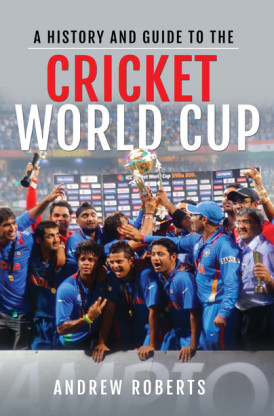History and Guide to the Cricket World Cup
Martin Chandler |Published: 2019
Pages: 189
Author: Roberts, Andrew
Publisher: White Owl
Rating: 3.5 stars

In less than two weeks’ time the twelfth Cricket World Cup begins. Some of us, this reviewer and Andrew Roberts included, can remember the Prudential Cup taking place back in 1975. That first tournament, memorable in many ways, comprised a total of fifteen matches and was done and dusted in a fortnight. The rapidly approaching twelfth edition will consist of 48 matches, and will take up more than six weeks of the English summer.
In 1975 the players wore whites, and the contests were 60 overs a side. Scoring rates, compared with what 2019 will see, were modest, the Australians failure by 17 runs in the final to overhaul a West Indies total of 291-8 being comfortably the highest aggregate between Test playing nations. The Australians lost as many as five men to run outs, testament in part to the West Indies’ fielding ability, but also to the Australian’s inexperience of the format. Overall the event was a great success, although the Aussies weren’t too enthused despite reaching the final – at the end of the fortnight, with four Tests against England to follow, skipper Ian Chappell said enough is enough.
Those naysayers there were melted away in the years that followed, and this year the cricketing world is anticipating another blockbuster of a competition. There will be many booklets, brochures and newspaper supplements to assist spectators and there have been at least three books dealing with the entire story that have been or will be published this year. This one is its author’s first book, and the second of the three I am aware of to land in bookshops.
Although the title of the book uses the word “guide” I am sure there will be other publications much better suited to that function. There is a useful fixture list at the beginning of the book, but little more than two pages describing the “players to watch” across ten teams does not a preview make.
As a history of the competition however the book is much, much better. It consists of a narrative account of each tournament coupled with, as you would expect from a man whose own website is to be found at www.andrewrobertscricketstatistics.com, an awful lot of numbers.
Statistics are an important part of the game and all cricket lovers have, to a greater or lesser extent, an interest them. That much said appearance is important when setting out cricket records and, generally, long lists are best avoided. The success that I hope comes the way of A History and Guide to the Cricket World Cup will be because of the way those numbers are presented. There are only so many ways in which the job can be done, and the Roberts’ method is informative, well structured and easy on the eye.
As a man who esteems Test cricket rather more than the humble ODI the World Cups, 1975 apart, have tended not to linger in the memory. As a result I much enjoyed Roberts’ reminders of what happened in each tournament, and was particularly impressed by those stories being told without reference to a single scorecard, not even for any of the finals. The feature that is certainly my favourite is the ‘Miscellany’ that appears in each chapter, sandwiched in between the narrative and the tournament stats.
To give a few examples the 1975 chapter cites the seven East African batsmen who were bowled by England’s bowlers as the record number of men to be dismissed that way in a single innings. The same tournament spawned as many as three of the six occasions a bowler has gone for less than a run an over for his full allocation – who were the parsimonious trio? Perhaps not surprisingly Bishan Bedi, Sir Richard Hadlee and John Snow. There are many more such interesting nuggets throughout the book.
Is there anything missing? Not being an expert on the format I probably wouldn’t know anyway, but there is no mention of one curious issue which, 36 years on, is causing a little consternation amongst some and which author and publisher might want to bear in mind when they update the book in 2023. All the record books, and Roberts, say that the leading wicket taker in the 1983 tournament, famously won by India against red hot favourites West Indies, was Roger Binny. There is a school of thought that says the record is in fact shared with the Sri Lankan Ashantha De Mel. the point at issue is whether it was De Mel (per Wisden) or Rumesh Ratnayake (per CricketArchive) who dismissed Geoff Howarth on 13 June? A well known Indian writer is, as I type, well and truly ‘on the case’.
There must be many who are looking forward to the 2019 World Cup who would like to know more about the history of the competition. To anyone fitting that description Andrew Roberts’ book is a recommended purchase.






Leave a comment